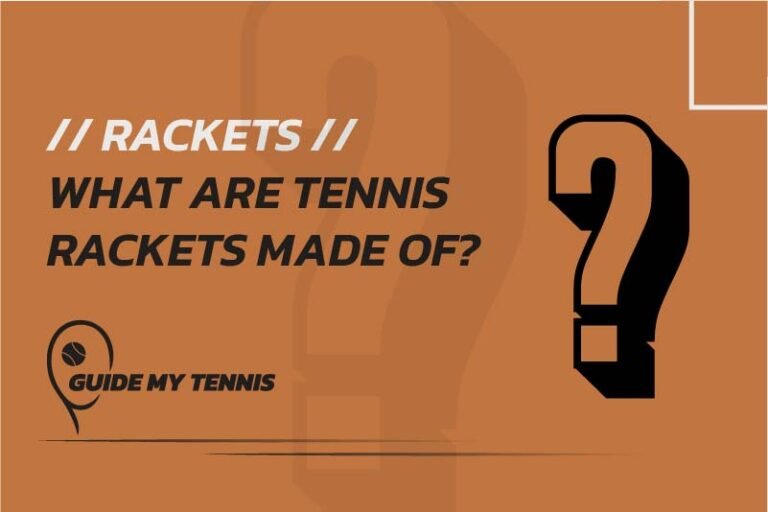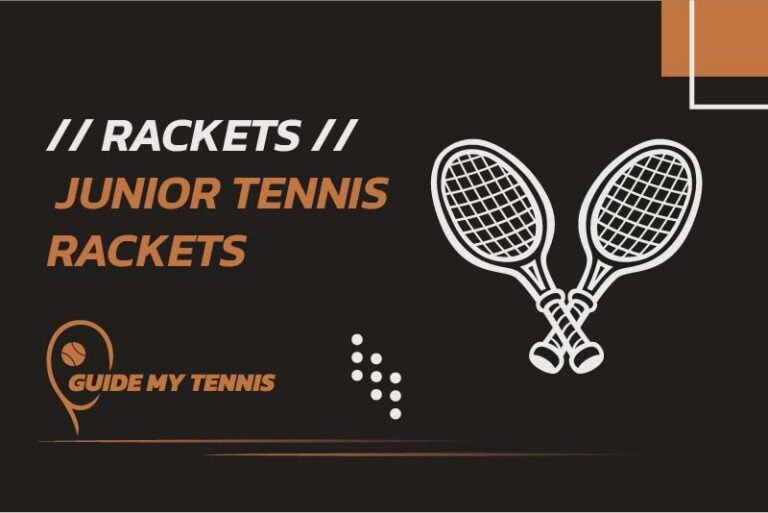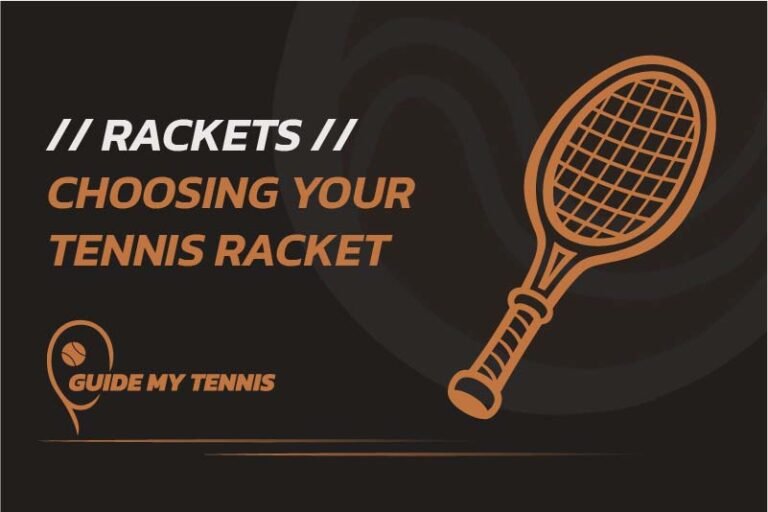Discover Tennis Racket Anatomy
Dive deep into this comprehensive guide about the anatomy of the tennis racket. Click to learn more about the different parts of the racket.

Hey everyone, I hope you’re all well while reading this comprehensive blog about tennis racket anatomy. As you may already know, tennis is a beautiful sport that balances athleticism, technique, and precision. As stated, the different parts of the racket will be reviewed and spoken about in great detail.
You can say that you are in for a comprehensive guide about the different parts of a tennis racket.
In tennis, importance is given to our groundstroke technique or how we move on the court, but we cannot forget about the various tennis racket components. Whether you’re a new tennis player or a newbie in the sport, this blog will teach you about the different parts of the racket.
An Overview of the Tennis Racket Anatomy
Having an overview of the tennis racket’s anatomy and knowing the purpose of the different parts of the racket will help in understanding the sport. An understanding of the tennis racket anatomy will also be critical when choosing the right tennis racket to suit your type of play.
Imagine going to a shop and getting asked about your preferences on the grip size and the head size of the tennis racket you’re after. Do you know what all that means?
The following infographic will give you an idea of where each part is located. As you can see, there exist many different elements in a tennis racket. But the good news is that this is all similar, regardless of the brand. Tennis racket anatomy can be said to be quite straightforward.

But of course, each tennis racket and its construction is different. Nowadays, we must also consider the technology and material being used. In the past, the material used for the construction of tennis rackets was primarily wood. Can you imagine how difficult it was to play with a wooden racket? But technology has evolved and so has the sport. Nowadays, tennis racket manufacturers are utilising modern technology coupled with high-end, sturdy materials to construct an array of tennis rackets with varying specifications. These materials include graphite, aluminium and carbon fibre.
So let us start from the bottom parts of the racket and work our way up, shall we?
The Handle
At the base, we have the tennis racket handle. Now this part of the racket may seem to be an ordinary handle, but this area has different parts, 4 different parts, to be precise.
Butt & Butt Cap
The first part is located at the very bottom of the tennis racket, that is the Butt and Butt Cap. The butt refers to the base of the racket. If you take a look at a normal racket, you can see that at the bottom the handle sort of widens. This helps tennis players stabilise the racket and prevent it from flying off with every groundstroke.
The butt cap refers to the piece of plastic at the bottom of the racket. This does not really play a significant role.
Handle / Grip
The Handle of the racket is the part where, of course, the tennis player holds their racket. That’s all for its functionality. However, the handle is one of those elements that really impacts whether a tennis racket suits you. In fact, it is one of the most important tennis racket components. The handle of a tennis racket comes in different diameter sizes. The smallest is grip size 0 (EU) or 4 inches (US) and this keeps on going all the way to grip size 5 (EU) or 4 ⅝ (US).
The grip size is important because a racket with a small grip would require more strength to keep it from twisting during play. This can cause some issues down the line, such as tennis elbow. On the other hand, a tennis racket with a grip that is way too large for you can be uncomfortable to play with and can also contribute to health issues, mainly tennis elbow.
How to Find Your Perfect Grip Size?
In order to find the perfect grip size, I have dedicated a whole blog just for this purpose. In this blog, you will find the two different methods to identify your ideal grip size alongside visuals to help you along the way. Here, you will also find a tennis racket grip size chart.
If you are unsure about the right grip size, you can always go for the smallest of the two, and then add an overgrip to increase the grip size. An overgrip is likely to give you an increase between 1.3 mm and 1.6 mm.
Different Types of Tennis Grips
Now, one other thing which is critical to notice about the tennis racket grip is that it has edges, it is not a circle, but takes on the shape of an octagon. These edges are called Bevels and there are a total of 8 bevels. Similar to the butt cap, these bevels were designed to keep the racket from twisting and moving whilst playing. But the way you hold your racket will impact the way you play. In fact, there are several different grips which vary according to which bevel you are holding. If you want to learn more about the different grips that exist in tennis, press here.
Grip Tape
Moving slightly upward, we find the edge of the grip. This is defined as the Grip Tape which holds the end of the grip attached to the rest of the grip so that the edge of the overgrip won’t fly around during play. This can sometimes also be accompanied by a rubber collar. This is like a ring which I made of rubber and its sole purpose is to help keep the edge of the grip in place.
The Shaft
The middle section is called the Shaft and here we can find the Throat of the racket. The throat is the part which connects the handle with the grip to the racket head, which we will be discussing shortly.
One fun fact about the throat is that back when the tennis racket was made out of wood, the throat used to be a solid block, with no hole! Quite a different construction to today, right? Tennis evolved, and so did the parts of a racket in tennis.
In reality, having an open throat stabilizes the racket head significantly, while a closed throat was used to enlarge the sweet spot and avoid off-centre hits.
The Racket Head
The next part is the racket head. This is the top part and is perhaps the part which we take note of the most since this is the part which is used to actually hit the balls. In reality, the racket is 1 tool, so every aspect of the tool is important and contributes to the overall performance.
Racket Head Size
The Racket Head can be considered to be a game-changer for the player. Its size has a big effect on how you strike the ball. Racket head size ranges from 95 to 110 square inches.
Remember, the smaller the racket head is the more control it has while the larger head size will provide more ease of power to its user.
Strings
Then we have the Strings. These impact how you play and as a component of the tennis racket, they have been given a subject on their own. They have a big impact on the way you perform on the court. The string bed consists of mains (strings running vertically) and crosses (strings running horizontally). The string bed also comes in different patterns. The most popular string bed is the 16×19 followed by the 18×20. The difference between the two string beds and more are covered in this article.
Do note that the strings are not there to be forgotten. These need to be replaced every so often as they will lose their tension and quality over time. Keeping them on until they snap is a rookie mistake. Don’t overdo it. If you need help with choosing the right string or finding yourself wanting to learn more about the job of the strings in a tennis racket, you can press here.
The racket head is comprised of other parts, albeit being less popular.
Grommets
The Grommets are those tiny holes that come out from the inside of the head. These are coupled with grommet strips, found on the outside of the head. Their main purpose is to hold the strings in place. Unless you are stringing your own tennis racket, that is all you need to know.
Rim and Bumper Guard
The Rim of the tennis racket is the part that extends around the outside of the strung area. The Bumper Guard is a piece of plastic located at the top of the racket. This protects the racket head from the occasional scratch that may occur with the tennis court surface. Thus protecting the racket from some nasty scratches and dents.
Concluding Remarks on the Overview of Tennis Racket Anatomy
Voila! You can now say that you are knowledgeable about tennis racket anatomy. If you want to be the next big ace, you have to start from somewhere right? Well, I think knowing what the different parts of the tennis racket constitute is a great first step, don’t you agree?
Remember, the tennis racket structure can be moulded by varying all these different parts. And these parts will impact the way you play. So if you want to learn how to improve your game, going over the tennis racket anatomy is a helpful first step. This applies to all players of any type. If you don’t know your tennis racket anatomy and structure, now is your chance to learn!
If you want to learn how to choose your next tennis racket, just click here!





